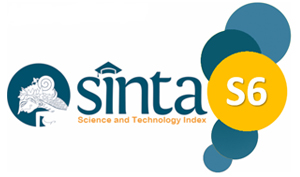OPTIMASI MENGGUNAKAN ALGORITMA STOCHASTIC GRADIENT DESCENT (SGD): STUDI BIBLIOMETRIK
DOI:
https://doi.org/10.30587/indexia.v7i1.9708Keywords:
Stochastic Gradient Descent (SGD), optimasi, pembelajaran mesin, bibliometrik, tren penelitian, klaster kata kunciAbstract
Penelitian ini bertujuan untuk menganalisis perkembangan riset mengenai algoritma Stochastic Gradient Descent (SGD) dalam konteks optimasi pembelajaran mesin menggunakan pendekatan bibliometrik. Sebanyak 55 artikel ilmiah yang dipublikasikan antara tahun 2020 hingga 2025 dianalisis untuk mengidentifikasi tren publikasi, kolaborasi penulis, kata kunci dominan, dan struktur tematik. Hasil kajian menunjukkan peningkatan signifikan publikasi terkait SGD, dengan fokus utama pada topik deep learning, optimization, dan generalization. Sebagai upaya untuk memperdalam pemahaman terhadap dinamika tersebut, penelitian ini menyertakan analisis visual menggunakan perangkat lunak bibliometrik VOSviewer dan Biblioshiny. Hasil visualisasi mengungkapkan lima klaster utama yang mencerminkan arah dan kedalaman riset SGD, serta tantangan yang dihadapi seperti sensitivitas terhadap learning rate dan kestabilan model. Temuan ini juga membuka peluang untuk penerapan algoritma SGD pada teknologi edge AI, mobile learning, serta sistem pembelajaran di daerah dengan keterbatasan infrastruktur.
References
[2] D. A. Roberts, ‘SGD Implicitly Regularizes Generalization Error’, 2021, arXiv. doi: 10.48550/ARXIV.2104.04874.
[3] Y. Zhou, Y. Liang, and H. Zhang, ‘Understanding generalization error of SGD in nonconvex optimization’, Mach. Learn., vol. 111, no. 1, pp. 345–375, Jan. 2022, doi: 10.1007/s10994-021-06056-w.
[4] T. Kobayashi, ‘Phase-wise Parameter Aggregation For Improving SGD Optimization’, in 2021 IEEE Winter Conference on Applications of Computer Vision (WACV), Waikoloa, HI, USA: IEEE, Jan. 2021, pp. 2624–2633. doi: 10.1109/WACV48630.2021.00267.
[5] T. Sun, D. Li, and B. Wang, ‘Stability and Generalization of the Decentralized Stochastic Gradient Descent’, 2021, doi: 10.48550/ARXIV.2102.01302.
[6] S. Zhao and Y. Liu, ‘Distributed Stochastic Compositional Optimization Problems over Directed Networks’, 2022, arXiv. doi: 10.48550/ARXIV.2203.11074.
[7] K. (Mr. ) Kamaludin and A. Prasetyadi, ‘Two Decades of Bibliometric Research in Indonesia’, LIGHT J. Librariansh. Inf. Sci., vol. 3, no. 1, pp. 32–43, Jun. 2023, doi: 10.20414/light.v3i1.7034.
[8] D. F. Al Husaeni and A. B. D. Nandiyanto, ‘Bibliometric Using Vosviewer with Publish or Perish (using Google Scholar data): From Step-by-step Processing for Users to the Practical Examples in the Analysis of Digital Learning Articles in Pre and Post Covid-19 Pandemic’, ASEAN J. Sci. Eng., vol. 2, no. 1, pp. 19–46, Jun. 2021, doi: 10.17509/ajse.v2i1.37368.
[9] A. Ninkov, J. R. Frank, and L. A. Maggio, ‘Bibliometrics: Methods for studying academic publishing’, Perspect. Med. Educ., vol. 11, no. 3, pp. 173–176, Dec. 2021, doi: 10.1007/S40037-021-00695-4.
[10] S. Horváth, D. Kovalev, K. Mishchenko, P. Richtárik, and S. Stich, ‘Stochastic distributed learning with gradient quantization and double-variance reduction’, Optim. Methods Softw., vol. 38, no. 1, pp. 91–106, Jan. 2023, doi: 10.1080/10556788.2022.2117355.
[11] H. Chen, Y. Tsang, and C. Wu, ‘When text mining meets science mapping in the bibliometric analysis: A review and future opportunities’, Int. J. Eng. Bus. Manag., vol. 15, p. 18479790231222349, Feb. 2023, doi: 10.1177/18479790231222349.
[12] M. M. Hossain, ‘Current status of global research on novel coronavirus disease (COVID-19): a bibliometric analysis and knowledge mapping’, F1000Research, vol. 9, p. 374, May 2020, doi: 10.12688/f1000research.23690.1.
[13] N. O. D. Ellili, ‘Bibliometric analysis and systematic review of environmental, social, and governance disclosure papers: current topics and recommendations for future research’, Environ. Res. Commun., vol. 4, no. 9, p. 092001, Sep. 2022, doi: 10.1088/2515-7620/ac8b67.
[14] Sutarman, M. A. I. Hutagalung, O. Darnius, and M. Y. P. El Sya’ban, ‘Stochastic Gradient Descents Optimizer and Its Variants: Performance of the Optimizers for Multinomial Logistic Models on Large Data Sets by Simulation’, Math. Model. Eng. Probl., vol. 11, no. 10, pp. 2823–2832, Oct. 2024, doi: 10.18280/mmep.111025.
[15] L. Kong and M. Tao, ‘Stochasticity of Deterministic Gradient Descent: Large Learning Rate for Multiscale Objective Function’, 2020, arXiv. doi: 10.48550/ARXIV.2002.06189.
[16] X. Chen, J. D. Lee, X. T. Tong, and Y. Zhang, ‘Statistical inference for model parameters in stochastic gradient descent’, Ann. Stat., vol. 48, no. 1, Feb. 2020, doi: 10.1214/18-AOS1801.
[17] A. G. Carlon, B. M. Dia, L. Espath, R. H. Lopez, and R. Tempone, ‘Nesterov-aided stochastic gradient methods using Laplace approximation for Bayesian design optimization’, Comput. Methods Appl. Mech. Eng., vol. 363, p. 112909, May 2020, doi: 10.1016/j.cma.2020.112909.
[18] F. T. Admojo and Y. I. Sulistya, ‘Analisis Performa Algoritma Stochastic Gradient Descent (SGD) Dalam Mengklasifikasi Tahu Berformalin’, Indones. J. Data Sci., vol. 3, no. 1, pp. 1–8, Mar. 2022, doi: 10.56705/ijodas.v3i1.42.
[19] B. Zuhri and N. H. Harani, ‘Studi Literatur: Optimasi Algoritma Machine Learning Untuk Prediksi Penerimaan Mahasiswa Pascasarjana’, J. Inform. Dan Teknol. Komput. J-ICOM, vol. 5, no. 1, pp. 01–10, Apr. 2024, doi: 10.55377/j-icom.v5i1.8074.
[20] A. T. N. Hartono and H. D. Purnomo, ‘Pengembangan Stochastic Gradient Descent dengan Penambahan Variabel Tetap’, J. JTIK J. Teknol. Inf. Dan Komun., vol. 7, no. 3, pp. 359–367, Jul. 2023, doi: 10.35870/jtik.v7i3.840.
[21] J.-H. Zhang, S.-Y. Ni, Y.-T. Tan, J. Luo, and S.-C. Wang, ‘A bibliometric analysis of PIN1 and cell death’, Front. Cell Dev. Biol., vol. 10, p. 1043725, Oct. 2022, doi: 10.3389/fcell.2022.1043725.
[22] D. Maulidiya, T. Utari, N. A. Irsal, and M. Aziza, ‘Investigasi pemanfaatan geogebra untuk pembelajaran matematika di Indonesia: Sebuah analisis bibliometrik’, Delta-Pi J. Mat. Dan Pendidik. Mat., vol. 12, no. 1, pp. 121–138, Sep. 2023, doi: 10.33387/dpi.v12i1.6557.
[23] Stefan cel Mare University, Suceava, Romania, A. Lucaci, M. Sarafescu, and Stefan cel Mare University, Suceava, Romania, ‘A Bibliometric Mapping of Innovative Entrepreneurship’, presented at the World Lumen Congress 2021, May 26-30, 2021, Iasi, Romania, Jan. 2022, pp. 360–371. doi: 10.18662/wlc2021/35.
[24] M. Theeraworawit, S. Suriyankietkaew, and P. Hallinger, ‘Sustainable Supply Chain Management in a Circular Economy: A Bibliometric Review’, Sustainability, vol. 14, no. 15, p. 9304, Jul. 2022, doi: 10.3390/su14159304.
[25] R. Supinah and J. Soebagyo, ‘Analisis Bibliometrik Terhadap Tren Penggunaan ICT Pada Pembelajaran Matematika’, JNPM J. Nas. Pendidik. Mat., vol. 6, no. 2, p. 276, Jun. 2022, doi: 10.33603/jnpm.v6i2.6153.
[26] Gitanissya Azzahra and Ghieska Maharani, ‘Analisis Bibliometrik : Brand Management dan Customer Loyalty (2010 – 2022)’, J. Ilm. Manaj. Ekon. Dan Akunt. JIMEA, vol. 1, no. 1, pp. 36–44, Nov. 2023, doi: 10.62017/jimea.v1i1.85.
[27] N. E. Lestari, J. Jumari, and A. Oktiawati, ‘Analisis Bibliometrik Pengaruh Madu sebagai Salah Satu Terapi Komplementer pada Balita dengan ISPA’, J. Nurs. Care Jur. Keperawatan Politek. Kesehat. Gorontalo, vol. 10, no. 1, p. 27, Mar. 2024, doi: 10.52365/jnc.v10i1.1031.
[28] Husnul Khuluq, Prasandhya Astagiri Yusuf, and Dyah Aryani Perwitasari, ‘A bibliometric analysis of coronavirus disease (COVID-19) mortality rate’, Bali Med. J., vol. 11, no. 2, pp. 579–586, Jul. 2022, doi: 10.15562/bmj.v11i2.3423.
[29] K. Ragazou, I. Passas, A. Garefalakis, and I. Dimou, ‘Investigating the Research Trends on Strategic Ambidexterity, Agility, and Open Innovation in SMEs: Perceptions from Bibliometric Analysis’, J. Open Innov. Technol. Mark. Complex., vol. 8, no. 3, p. 118, Sep. 2022, doi: 10.3390/joitmc8030118.
[30] J. Y. Ng, H. Liu, A. Q. Shah, L. S. Wieland, and D. Moher, ‘Characteristics of bibliometric analyses of the complementary, alternative, and integrative medicine literature: A scoping review protocol’, F1000Research, vol. 12, p. 164, Oct. 2023, doi: 10.12688/f1000research.130326.2.
[31] Y. Esidir and A. B. Gültekin, ‘A Bibliometric Analysis on Life Cycle Assessment of Bricks’, Period. Polytech. Archit., vol. 54, no. 1, pp. 63–72, Apr. 2023, doi: 10.3311/PPar.21399.
[32] R. Yanti, M. A. Febrianti, Qurtubi, and J. Sulistio, ‘Halal blockchain: Bibliometric analysis for mapping research’, Asian J. Islam. Manag. AJIM, pp. 72–85, Aug. 2022, doi: 10.20885/AJIM.vol4.iss1.art6.
[33] A. F. W. Haq, S. Supian, and D. Chaerani, ‘Systematic Literature Review on Troubleshooting Delivery of Production Product Using n-Vehicle with Vogel Total Difference Approach Method’, Jambura J. Math., vol. 4, no. 2, Jun. 2022, doi: 10.34312/jjom.v4i2.14124.
[34] J. P. C. Ribeiro, F. Duarte, and A. P. M. Gama, ‘Does microfinance foster the development of its clients? A bibliometric analysis and systematic literature review’, Financ. Innov., vol. 8, no. 1, p. 34, Dec. 2022, doi: 10.1186/s40854-022-00340-x.
[35] S. K. M. Brika, ‘A Bibliometric Analysis of Fintech Trends and Digital Finance’, Front. Environ. Sci., vol. 9, p. 796495, Jan. 2022, doi: 10.3389/fenvs.2021.796495.
[36] L. Poláček, M. Ulman, P. Cihelka, and E. Šilerová, ‘Dynamic Pricing in E-commerce: Bibliometric Analysis’, Acta Inform. Pragensia, vol. 13, no. 1, pp. 114–133, Apr. 2024, doi: 10.18267/j.aip.227.
[37] H. L. Khairunnisa and A. S. Rusydiana, ‘Mapping on Islamic Microfinance Research: Lesson Learn from Indonesia and Turkey’, Econ. Sustain., vol. 1, no. 1, Feb. 2024, doi: 10.58968/es.v1i1.411.
[38] C. Rosalinda, N. Budiwati, and I. A. Ramadhan, ‘Blended Learning In Higher Education: A Bibliometric Analysis’, Pedagonal J. Ilm. Pendidik., vol. 6, no. 2, pp. 238–252, Oct. 2022, doi: 10.55215/pedagonal.v6i2.5775.
[39] D. R. S. Saputro, H. Prasetyo, A. Wibowo, F. Khairina, K. Sidiq, and G. N. A. Wibowo, ‘BIBLIOMETRIC ANALYSIS OF NEURAL BASIS EXPANSION ANALYSIS FOR INTERPRETABLE TIME SERIES (N-BEATS) FOR RESEARCH TREND MAPPING’, BAREKENG J. Ilmu Mat. Dan Terap., vol. 17, no. 2, pp. 1103–1112, Jun. 2023, doi: 10.30598/barekengvol17iss2pp1103-1112.
[40] S. Maulida and A. S. Rusydiana, ‘What is Islamic Management? A Previous Studies’, Manag. Sustain., vol. 1, no. 1, Nov. 2023, doi: 10.58968/ms.v1i1.288.
[41] A. Hariry, E. Mardawati, and N. Masruchin, ‘Nanocellulose Research Trends from Pineapple Plant Waste in Indonesia: Bibliometric Analysis Using VosViewer’, AJARCDE Asian J. Appl. Res. Community Dev. Empower., vol. 7, no. 2, pp. 1–7, Feb. 2023, doi: 10.29165/ajarcde.v7i2.247.
[42] A. As-Salafiyah, ‘COVID-19 and Halal Food: An Application of Text Analytics’, Halal Food Stud., vol. 1, no. 1, Mar. 2024, doi: 10.58968/hfs.v1i1.449.
[43] D. Li, J. Jiao, S. Wang, and G. Zhou, ‘Supply chain resilience from the maritime transportation perspective: A bibliometric analysis and research directions’, Fundam. Res., vol. 5, no. 2, pp. 437–449, Mar. 2025, doi: 10.1016/j.fmre.2023.04.003.
[44] M. Amar, A. Junaidi, D. B. P. Lesmana, and T. W. Abadi, ‘Unveiling Trends in Online Learning Impact via Zoom and Google Meet’, Inf. Sci..
[45] M. S. Celestino, R. C. B. Belluzzo, J. P. Albino, and V. C. P. N. Valente, ‘ANÁLISE BIBLIOMÉTRICA: REVISÃO DE LITERATURA E PROPOSTA DE FRAMEWORK METODOLÓGICO EM 12 PASSOS’, ARACÊ, vol. 6, no. 4, pp. 13421–13446, Dec. 2024, doi: 10.56238/arev6n4-146.
[46] I. Baako, ‘A Bibliometric investigation of Artificial Intelligence in Technical and Vocational Education Training (AI-TVET): Trends and insights for a decade’, Apr. 15, 2025, In Review. doi: 10.21203/rs.3.rs-6431518/v1.
[47] S.-Y. Hsu, T.-W. Chien, Y.-T. Yeh, and S.-C. Kuo, ‘Citation trends in ophthalmology articles and keywords in mainland China, Hong Kong, and Taiwan since 2013 using temporal bar graphs (TBGs): Bibliometric analysis’, Medicine (Baltimore), vol. 101, no. 52, p. e32392, Dec. 2022, doi: 10.1097/MD.0000000000032392.
[48] E. Supriyadi, A. Septian, J. A. Dahlan, and D. Juandi, ‘GeoGebra Research in Indonesia: A Bibliometric Analysis’, PRISMA, vol. 11, no. 2, p. 559, Dec. 2022, doi: 10.35194/jp.v11i2.2572.
[49] M. H. M. Zein, I. Meiyenti, and I. Agustina, ‘Analisis Bibliometrik tentang Pengembangan Keuangan Berkelanjutan: Identifikasi Tren, Konsep Kunci, dan Kolaborasi dalam Literatur Akademis’, J. Akunt. Dan Keuang. West Sci., vol. 2, no. 03, pp. 150–160, Sep. 2023, doi: 10.58812/jakws.v2i03.654.
[50] E. Fauziyah and S. Sanudin, ‘The Covid-19 Pandemic and Farmer Livelihood in a Rural Area: a Bibliometric Analysis’, in Proceedings of the 3rd International Conference on Rural Socio-Economic Transformation: A Transdisciplinary Approach for Promoting Sustainable, Resilience, and Just Rural Transitions in the Era of Climate Crisis, RUSET 2022, 10-11 August 2022, Bogor, Indonesia, Bogor, Indonesia: EAI, 2023. doi: 10.4108/eai.10-8-2022.2338894.
[51] R. Kusharyadi, S. Pertiwi, E. Y. S. Siahaan, and D. Dasari, ‘Bibliometric Analysis: Sofware Usage Trends GeoGebra in Mathematics Learning From 2017 - 2022’, Prisma Sains J. Pengkaj. Ilmu Dan Pembelajaran Mat. Dan IPA IKIP Mataram, vol. 11, no. 1, p. 196, Jan. 2023, doi: 10.33394/j-ps.v11i1.6786.
[52] F. Orsi, ‘On the sustainability of electric vehicles: What about their impacts on land use?’, Sustain. Cities Soc., vol. 66, p. 102680, Mar. 2021, doi: 10.1016/j.scs.2020.102680.
[53] Y. Guo, E. H. Boughton, and J. Qiu, ‘Interactive effects of land-use intensity, grazing and fire on decomposition of subtropical seasonal wetlands’, Ecol. Indic., vol. 132, p. 108301, Dec. 2021, doi: 10.1016/j.ecolind.2021.108301.
[54] J. T. Staley et al., ‘Designing a survey to monitor multi-scale impacts of agri-environment schemes on mobile taxa’, J. Environ. Manage., vol. 290, p. 112589, Jul. 2021, doi: 10.1016/j.jenvman.2021.112589.
[55] M. Salman, D. Zha, and G. Wang, ‘Indigenous versus foreign innovation and ecological footprint: Dynamic threshold effect of corruption’, Environ. Sustain. Indic., vol. 14, p. 100177, Jun. 2022, doi: 10.1016/j.indic.2022.100177.



 Template INDEXIA
Template INDEXIA



